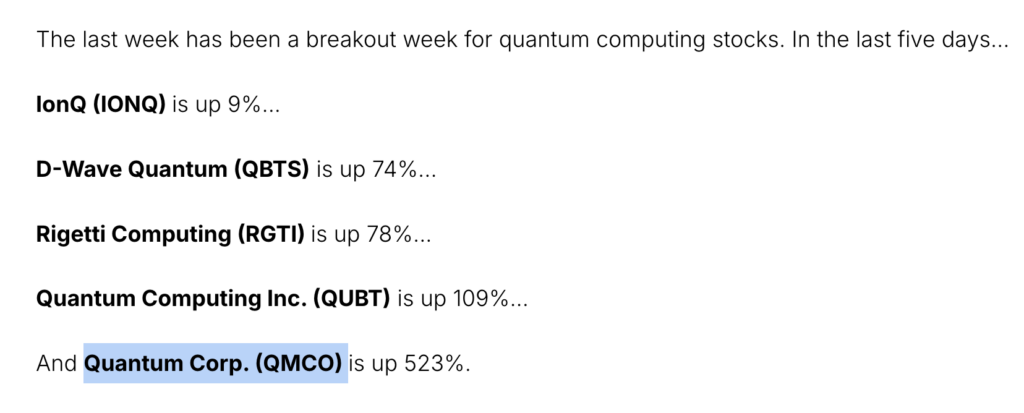Quantum Stocks: Weighing The Bullish and Bearish Cases

Insider Brief
- Quantum stocks are surging with dramatic gains, including: Quantum Computing Inc. (QUBT) skyrocketed 419%, D-Wave Quantum (QBTS) rose 125%, IonQ (IONQ) climbed 72%, and Rigetti Computing (RGTI) increased by 46% in just the past month.
- Collaborations with tech giants like NVIDIA and breakthroughs in error correction, including Quantinuum’s topological qubit and Microsoft-Atom Computing’s logical qubit work, highlight growing confidence in the quantum sector.
- Persistent financial losses, mislabeling of quantum companies, and concerns about pump-and-dump schemes emphasize the need for cautious, informed decision-making.
Quantum technology stocks have surged in recent weeks, drawing increased attention from investors. Companies like IonQ, D-Wave Quantum, Rigetti Computing, and Quantum Computing Inc. have seen significant gains.
Breaking it down, just to pinpoint how dramatic that rise has been: Quantum Computing Inc. (QUBT) skyrocketted 419% over the last month. IonQ (IONQ) has climbed 72%, Rigetti Computing (RGTI) is up 46% and D-Wave Quantum (QBTS) has risen 125%.
The upswing in prices has been so extreme that quantum companies have now even been featured on CNBC’s Jim Cramer show.
While these numbers are eye-catching and this awareness is — at least initially — a good thing for the quantum industry, prospective investors should weigh both the bullish and bearish cases for quantum technology stocks.
And a quick note: the following is not investment advice but rather an examination of the forces driving these movements and the risks they entail. The actual investment advice is to always weigh the positive, the negative — and measure your own risk position.
OK. Here we go.
The Bullish Case
Industry Partnerships and NVIDIA’s Quantum Push
Quantum technology has garnered growing support from tech heavyweights. NVIDIA, a leader in artificial intelligence and GPUs, has stepped into the quantum domain with its CUDA-Q platform. This hybrid quantum-classical computing platform promises to accelerate quantum research by simulating quantum processors on powerful supercomputers.
NVIDIA’s recent collaborations with Google Quantum AI, IonQ, and Anyon Technologies highlight its commitment to the space. Google is using NVIDIA’s Eos supercomputer to simulate quantum processors, addressing hardware limitations caused by noise in quantum systems. Similarly, IonQ integrated CUDA-Q into its workflow, demonstrating an end-to-end application that combines NVIDIA’s hardware with quantum systems.
In Europe, Quantum Brilliance sold its first room-temperature quantum accelerator to Fraunhofer IAF, leveraging NVIDIA’s platform. These collaborations reflect a growing ecosystem that combines quantum technologies with classical computational power, making quantum applications more feasible for enterprise use.
Improving Financials
IonQ recently reported $12.4 million in Q3 revenue, more than doubling its revenue from the same period last year. The company also raised its full-year guidance, signaling strong demand and robust growth.
D-Wave Quantum also showed gains in quantum cloud revenue, though this was offset by increasing losses. Even these modest improvements suggest quantum firms are inching closer to commercial viability, buoyed by government projects and enterprise partnerships.
Technological Advances
Technological progress is also driving optimism. Microsoft and Atom Computing unveiled a system with 24 logical qubits, the largest number of entangled logical qubits achieved to date. The system, available for pre-order with delivery slated for 2025, marks a milestone in error correction and quantum reliability. (Here’s a breakdown of that research.)
Topological quantum computing, a promising approach to reducing errors, also saw advances with Quantinuum and collaborators demonstrating the first-ever topological qubit. By encoding information in the braiding properties of quasiparticles, the researchers aim to build more robust systems with lower error correction overhead.
The Bearish Case
Financial Fragility
Despite revenue growth, quantum firms are far from profitability. Losses remain a consistent theme across the sector, even as companies achieve technical milestones. Investors should temper expectations, as scaling quantum systems and achieving fault tolerance — necessary for practical applications — edge closer, but remain significant challenges.
Hype and Mislabeling
Not all companies that analysts are touting in this quantum stock rally are true quantum computing companies — or even quantum players at all.

The Cabot Wealth newsletter, for example, lists Quantum Corp. as a quantum computing company — which saw its stock surge 523%, largely on the back of an earnings report showing adjusted EBITDA breakeven. However, Quantum Corp. is not a quantum computing company. It doesn’t even seem to have anything to do with quantum at all.
But it does show how adding the label “quantum” to a product, doesn’t make it quantum.
Pump-and-Dump Risks
There is growing concern that some traders may be artificially inflating quantum stock prices. Sudden spikes in share value can sometimes indicate pump-and-dump schemes, where traders drive up prices to sell their positions before a rapid decline. A recent report from Iceberg Research calls into question recent news releases from Quantum Computing Inc. — one of the largest gainers in the most recent quantum bull market — about its chip foundry and the company’s alleged new customers.
The speculative nature of the quantum market makes companies in the sector especially vulnerable to such pump-and-dump activity — and often the target of such activity when innocent of the accusations. Without clear and consistent revenue streams, investors may grow skeptical, questioning the legitimacy of a company’s operations or the viability of its business model. In the absence of tangible financial evidence, accusations of mismanagement or even nefarious activities could surface, undermining trust and damaging the company’s reputation. In fact, this negative speculation — given enough time and a failure to show real financial results — could tarnish the entire quantum market.
Technical and Market Uncertainty
The industry is still navigating the transition from Noisy Intermediate-Scale Quantum (NISQ) systems to fault-tolerant quantum computers. While progress has been made, the timeline for achieving commercially viable quantum solutions remains uncertain. Investors banking on near-term breakthroughs could face prolonged waiting periods before seeing tangible returns.
Navigating the Quantum Landscape
The quantum sector sits at the intersection of transformative potential and high risk. Bulls argue that technological advances and heavyweight partnerships are accelerating quantum’s path to relevance. Companies like NVIDIA and Microsoft are injecting credibility and resources into the ecosystem, while improving financial results signal incremental progress.
However, bears caution that the industry remains speculative, with most firms operating at a loss. Mislabeling and speculative trading further cloud the investment landscape. For every legitimate player, there is a risk of overhyped companies capitalizing on the quantum narrative.
As the sector matures, distinguishing between hype and substance will be critical for investors. While the promise of quantum technology is undeniable, the path to profitability is still fraught with uncertainty.
Understanding both the potential and the risks is essential for navigating this emerging market. The quantum market has grown and now includes more publicly listed firms — and we expect that number to grow in the company years and even the coming months. To better guide investors’ decisions and improve transparency in this emerging market, The Quantum Insider is now including public market metrics in TQI’s Intelligence Platform.
